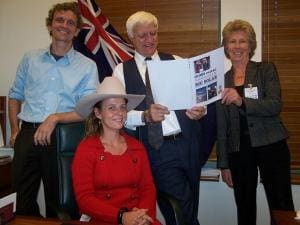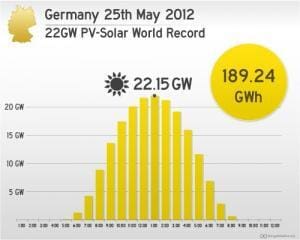A new report released by the Australian Energy Market Operator (AEMO), could mark the tipping point after which solar photovoltaics (PV) will transform from a technology widely seen as novel and uneconomical to most Australians into one seen as a bona fide major league player in the electricity generation game. Some of the most prominent voices in the solar industry argue that politicians should recognise this fact sooner rather than later and plan for Australia’s energy future accordingly.
The AEMO report that could (should) change the way that the Australia views solar PV
Bill Gates once famously dismissed solar power as a ‘cute’ solution to the world’s impending energy crisis, implying that the technology would never become a viable source of power for modern, industrialised economies. Gate’s view is not an uncommon one globally and within Australia; solar PV and other forms of solar and renewable energy generation have widely been overlooked, written off as pipe dreams, or ignored in Australian politics and by the existing power generation establishment, which would rather stick with tried-and-true coal-fired generation. The dream of ubiquitous rooftop solar PV is seen as just that, and botched incentive schemes such as NSW’s poorly managed Solar Bonus Scheme are seen as further proof that this is indeed the case.
A recent report by the Australian Energy Market Operator, however, makes it much more difficult for anyone to ignore reality that solar power will have a strong presence in Australian power generation. The report predicts that solar PV will produce between 12,000 megawatts (MW) and 18,000MW (around 10%) of Australia’s power by 2031 (by means of comparison, the total installed capacity at the end of 2011 was 1408MW. The predictions are optimistic thanks in great part to the rapidly declining price of solar PV system installations and their increasingly attractive return on investment due to Australia’s rising electricity prices. The report also mentions the benefits that rooftop solar PV installation of this scale will likely have for the electricity grid, especially in terms of reducing peak demand and the need to build more large-scale (usually coal-fired) power plants.
Soon after the release of the report, RenewEconomy‘s Giles Parkinson, an outspoken and articulate clean energy proponent, published an op-ed piece in the ordinarily conservative Australian newspaper, openly calling for the government to recognise the importance and potential of solar PV and to act on it. The article begins with: “It’s time politicians in state and federal parliaments look at what’s happening in the solar photovoltaic market. There is a revolution going on in the electricity industry and no one in politics seems to have noticed.”
On a similar note, solar industry analyst Nigel Morris of Solar Business Services emphasises the report’s importance, especially in light of the virtual omission of solar PV’s future in a different report released by the Australian Strategic Policy Institute in December 2011. Says Morris:
AEMO has two core operational roles: power system operator and market operator. AEMO delivers an array of gas and electricity market, operational, development and planning functions. It manages the National Electricity Market (NEM) and the Victorian gas transmission network. AEMO also facilitates electricity and gas full retail contestability, overseeing these retail markets in eastern and southern Australia. It is additionally responsible for national transmission planning for electricity and the establishment of a Short Term Trading Market (STTM) for gas.
So in terms of regulatory “punch” and “influence”, they have loads of it.
The AEMO Rooftop PV Information Paper 2012 was recently, quietly released and I eagerly await a response from Government acknowledging how wrong its forecasts were, and how serious the business of solar is. Now.
Grassroots group 100% Renewable Energy visits Parliament house to call for Big Solar

Meanwhile, it seems all to appropriate that Australia’s grass-roots renewable energy advocacy group 100% Renewable Energy held meetings in Canberra this week, sitting down MP’s with their constituents to talk Big Solar. 100% Renewables is quick becoming the people’s bullhorn, amplifying the smaller disparate voices calling for the broad-scale uptake of renewable energy technologies, with the aim of fostering political will higher up. 100% Renewable’s mission to the capital was characterised by its honesty, civility, and overall wholesomeness; proof that the call for a transition to renewable energy generation is not coming from the fringes of society, but instead from ordinary citizens nation-wide. (The group’s efforts complement the work done by Beyond Zero Emissions‘ to create and promote a technologically credible, engineering-based vision for a 100% clean energy Australia.)
…and Germany sets a world solar power record!

Finally, as if to drive home the point, Germany has recently set a world solar power generation record, with nearly 30% (22.4 gigawatts) of its generation coming from solar PV for a period of a few hours on a Friday afternoon. As Cleantechnica points out, this number only begins to tell the story of what is going in that country. The author writes:
[I]n my opinion, the story of this solar energy record shouldn’t stop at the number of 22.15 GW [gigawatts] of peak output. In fact, the really meaningful story starts with a different number: 189.24 GWh [gigawatt-hours]. That’s the amount of electrical energy generated from more than a million PV solar systems spread all over the country on that record day. Not only was this almost 14% of Friday’s total electricity consumption in Germany, it was also, actually, not that unusual.
For the last couple of weeks, the output of PV solar peaked within an inch of the 20 GW line several times, and it never peaked very low throughout the month. The lowest peak load was 8 GW, while the average peak load of PV solar was 16 GW. So, it seems that solar is not as unreliable as conventional wisdom and media outlets often lead people to believe. Because I can tell you that we didn’t have 4 weeks straight of sunshine here in Germany, that’s for sure.
Looking at the daily power production during the first 4 weeks of May makes this even more obvious. While it is not a constant increase day by day, the weekly output is increasing steadily as we are heading towards mid-summer. During the first week of May, solar energy produced about 780 GWh of electric power; and, at the end of the month, during the record-breaking week, it amounted to 1,096 GWh or 1.1 TWh [terawatt-hours]. Those were enough GWhs to meet almost 12% of the total power needs in Germany that week!
Source: Clean Technica (http://s.tt/1d6fP)
So with any luck, even if the next Australian parliamentary election sees a switch to a Liberal government, hopefully the message is well and truly across that solar power is going to have a place in Australia’s energy future, and will get the respect and support that it deserves.
Top image via CleanEnergyFuture.gov.au
© 2012 Solar Choice Pty Ltd
- Solar Power Wagga Wagga, NSW – Compare outputs, returns and installers - 13 March, 2025
- Monocrystalline vs Polycrystalline Solar Panels: Busting Myths - 11 November, 2024
- Solar Hot Water System: Everything You Need to Know - 27 February, 2024